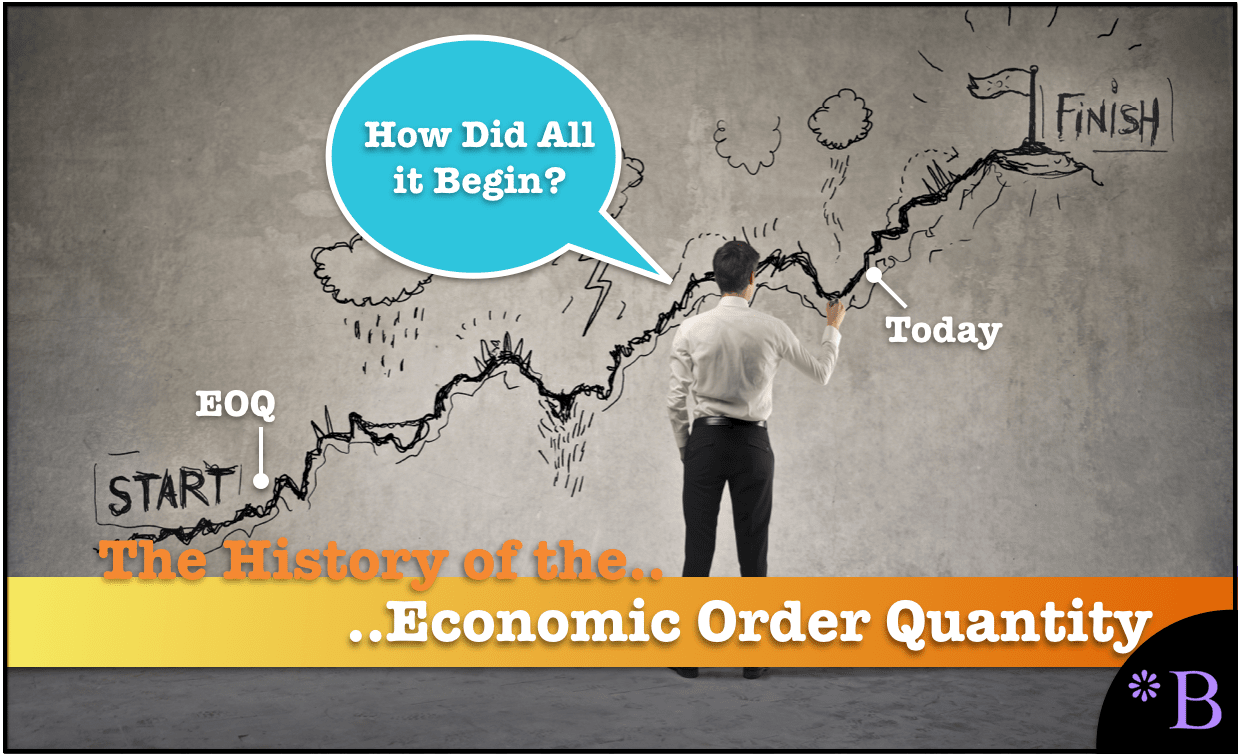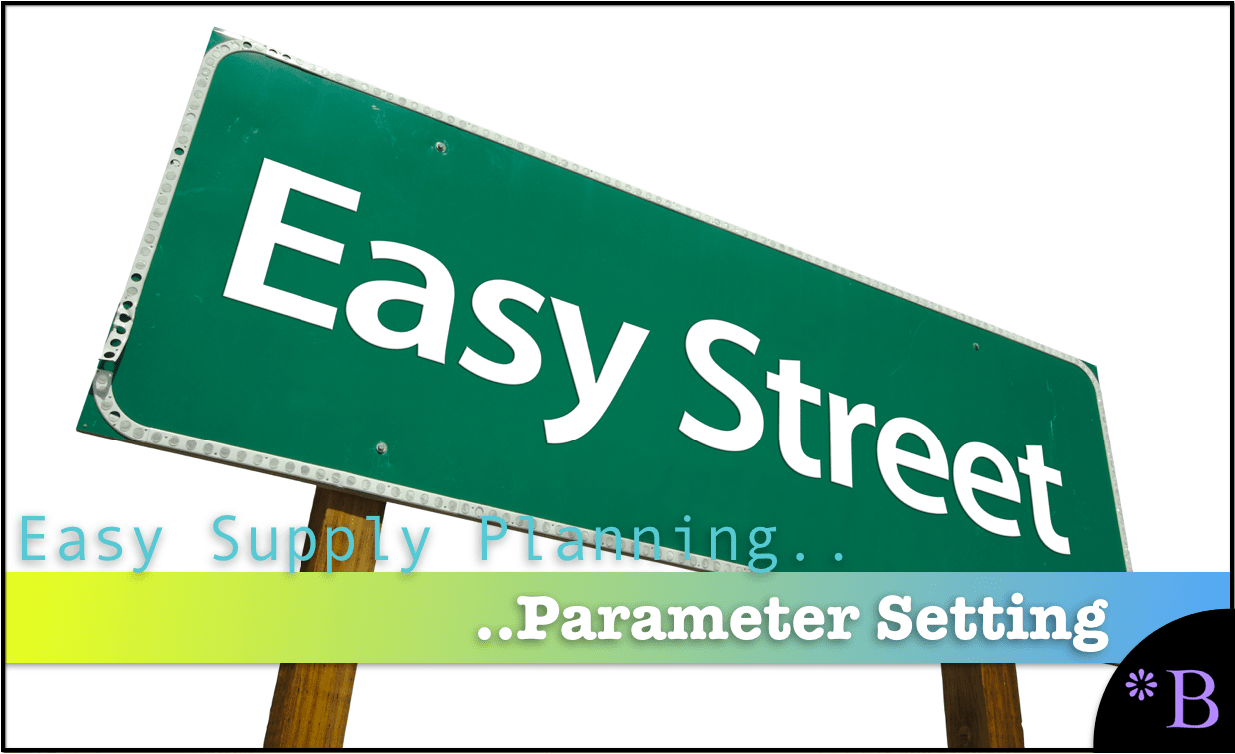How to Understand the History of the Economic Order Quantity Formula
Executive Summary
- This is an introduction to the economic order quantity formula.
- We analyze Ford W. Harris’ original economic order quantity paper.
- We cover using the economic order quantity in production planning systems.

Introduction
Economic order quantity (EOQ) is one of the oldest formulas in inventory management. EOQ was first developed by an unlikely person in 1913. Ford W. Harris had a high school education when he developed his EOQ formula. Since its introduction, EOQ has been one of the most important and durable formulas in inventory management. You will learn the history of the EOQ formula and Ford W. Harris’s paper that introduced EOQ to the world.
Our References for This Article
If you want to see our references for this article and related Brightwork articles, see this link.
Who Developed the Economic Order Quantity Formula?
Companies and universities tend to claim to have invented almost everything.
As with the development of MRP, the originator of the Economic Order Quantity Formula was not an academic and was unassociated with any company. He sought a way to make rational ordering decisions with some quantitative support. This shows two crucial supply chain planning developments were developed outside the traditional system.
- MRP Development: Orlicky, Plossl & Wight were employed at JI Case and Stanley Tools in the 1960s. They were trying to solve inventory problems at these companies. However, JI Case and Stanley Tools did not contribute to the work.
- EOQ Development: Ford W. Harris had no affiliation and was not an academic. While he later became an attorney, when he developed the EOQ formula, he had only a high school education.
This is not exclusive to supply chain innovations. For instance, Einstein had no university affiliation while working as a patent clerk when he wrote his papers. He later gained university affiliation with top schools after he did his most important work. Not only did Einstein have no university affiliation when he wrote his four breakthrough papers, but he had also applied for and been rejected as a high school science teacher in the years before his discoveries.
Issac Newton, College Drop Out?
Another example is Issac Newton, who did have a university affiliation. He was not a professor when he developed his calculus, optics, and gravitation theories. These were all established while he was away from Cambridge for two years. Newton’s papers could not be published for roughly 13 years because the Royal Society head was envious of Newton. He took credit for anything Newton published. Therefore, Newton stopped publishing during this time. Finally, this individual died, and Newton became the head of the Royal Society; therefore, what are widely considered to be the two most significant scientists in history had no university affiliation when they made their discoveries.
An Analysis of Ford W. Harris’ Economic Order Quantity Formula Paper
Most people find out about EOQ secondhand. The original paper How Many Parts to Make at Once is quite good. It is not only well laid out, but it is also well written. Far more so than the vast majority of papers I have read by academics. That is, people with much more education than Harris had at the time could not write as well as Harris could. The article is also short compared to other academic journals in the field.
Some exciting quotations from this paper follow:
“The writer has seen the practical workings of a first class stock system and does not wish to be understood as claiming that any mere mathematical formula should be depended upon entirely for determining the amount of stock that should be carried or put through on an order. This is a matter that calls, in each case, for trained judgement, for which there is no substitute. There are many factors of even more importance than those given in this discussion.”
This is quite an exciting quotation because subsequent authors who wrote on EOQ strongly tended to present the EOQ formula as much more final.
“But in deciding on the best size of order, the man responsible should consider all the factors that are mentioned. While it is perfectly possible to estimated closely enough what effect these factors will have, the chances are many mistakes costing money will be made. Hence, using the formula as a check is at least warranted.”
This quotation envisions the EOQ as a check to compare against human judgment. This paper was written in 1913, and no computers were used in this or any other area. The EOQ formula that Harris was proposing would be calculated by hand. Supply planning software applications do not compute EOQ formulas.
Changing the Cost of Computing the EOQ Formula
This changes the cost of computing the formula. It also changes the interpretation of how the EOQ formula can be used.
One would like to go back in time to ask Harris a question. That question would be given the advantages of computing power; he would still think the same thing he wrote back in 1913.
“In conclusion, it may be well to say that the method given is not rigorously accurate, for many minor factors have purposely been left out of the consideration. It may be objected that interest and depreciation should be figured, not only on original cost, but also on the setup cost, since that has to be incurred before the parts can be stocked. Such refinements, however, while interesting, are too fine spun to be practical. The general theory as developed here is reasonably correct to be found to give good results.”
Harris proposes that other factors could be used here, but he feels confident that the formula encompasses the most critical elements for driving orders. It is also interesting because his basic EOQ formula has been added over the following years with many additional costs and considerations.
List of EOQ Formula Adjustments
Just a sample of these are listed below:
- EOQ Revisited with Sustainability Considerations
- Study of EOQ-based Inventory and Transportation
- EOQ and Inflation Uncertainty
- An EOQ Model for a Perishable Product with Special Sale and Shortage
- Optimal Replenishment Cycle in an EOQ Model with Defective Items
- The Stochastic EOQ Model with Random Sales Price
- An EOQ Model for Deteriorating Items Under Credit Options
- EOQ Model with Stock-Dependent Demand
Using Economic Order Quantity Formula in Production Systems
After calculating the Economic Order Quantity Formula, the output is most often placed into the minimum order quantity field. This sets the minimum order level. Sometimes, other factors, such as being more significant than this level, are when products must be purchased in rail carloads. In that case, no EOQ calculation is necessary. The minimum order quantity is the carload.
The formula is one of the easiest to calculate in the supply management chain. Many companies do not determine their unconstrained (that is, unconstrained by minimum order sizes, such as the example of the carload or minimum package quantities) products by EOQ. However, aside from work effort, there is no reason not to do so. Most companies don’t get around to calculating EOQ, or if they do calculate it, they do so very infrequently. Students are often told that EOQ is used in the industry very frequently — when, in fact, it isn’t.
But this does not mean that it should not be — it certainly adds value, quantifies, and then trades off the most relevant costs for ordering.
That is the truth of how lean the staffing is in supply chain management. They do not have the staffing to apply elementary inventory management techniques over 80 years old.
While placing this into supply planning systems in the product record parameters would be easy, it is not done. Software vendors tend to assume that companies will periodically calculate the value externally.
How Should EOQ and Other Supply Planning Parameters be Calculated?
One would be able to, for example:
Item #1: Simulation
Set the supply planning parameters in a way that one can simulate the impact on the overall supply plan. When using supply planning systems, inventory parameters are typically managed on a "one by one" basis. This leads to individual planners entering values without considering how inventory parameters are set across the supply network.
Item #2: Interactivity of Changes
This is the ability to see the relationship between changes to service levels and the simulated output.
Item #3: Seeing Financial Implications
This is the ability to see the impact on the dollarized inventory for different aggregate settings.
Item #4: Mass Change for Efficient Maintenance
This allow the parameters to be changed en mass or as a mass change function. Both supply planning systems are designed to receive parameters; they are not designed to develop the parameters.
 Getting to a Better Parameter Setting Capability
Getting to a Better Parameter Setting Capability
We developed an approach where EOQ and reorder points are calculated externally, which allows for a higher degree of control. And for the average inventory to be coestimated in a way that provides an observable total system inventory, holding cost, service level, and a picture of what is happening to the overall system. Calculating individual parameters like EOQ without an appreciation for the systemwide does not make any sense. Also, in many, perhaps even most cases, there is no reason to use EOQ for the purposes given above. Instead, an alternative custom order batching method can be created to replace EOQ. There is nothing magical about EOQ. It is not a "best practice." It will not provide you with "digital transformation." It is not "Six Sigma." You will not get a "black belt" for using it.
After observing ineffective and non-comparative supply planning parameter setting at so many companies, we developed, in part, a purpose-built supply planning parameter calculation application called the Brightwork Explorer to meet these requirements.
Few companies will ever use our Brightwork Explorer or have us use it for them. However, the lessons from the approach followed in requirements development for supply planning parameter maintenance are important for anyone who wants to improve order batching and supply parameters.
Conclusion
The history of economic order quantity development turns out to be interesting. It’s a story of how a high school-educated engineer made the most enduring inventory management contribution. The EOQ formula is coded into nearly every supply and production planning application.
To calculate the EOQ formula online, see our EOQ Calculator at this link.
Also, learn about the limitations of EOQ at this link.